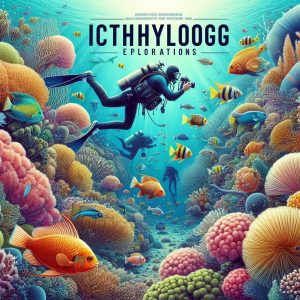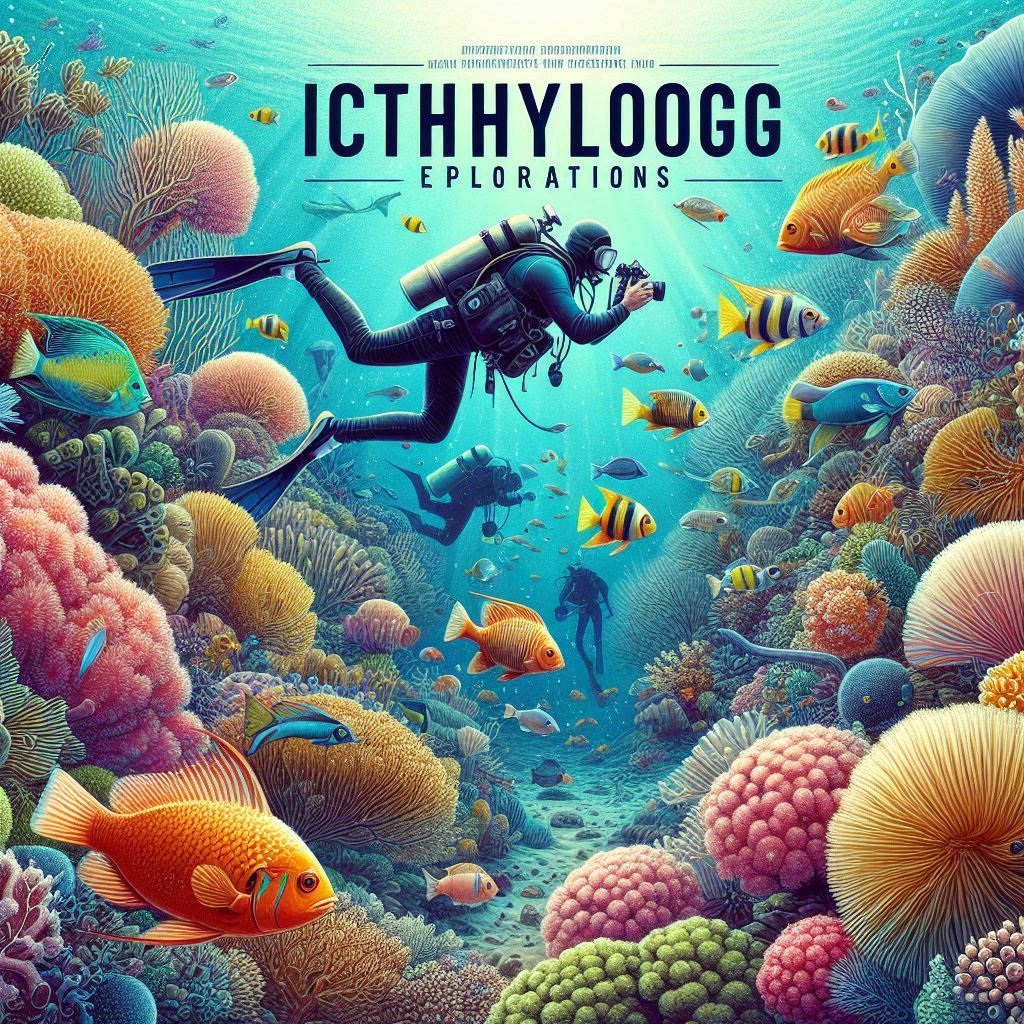Ichthyology introduction:
Ichthyology is the branch of zoology that focuses on the study of fish. This field encompasses the anatomy, behavior, ecology, and classification of fish species. Ichthyologists work to understand the diverse forms and functions of fish, their roles in ecosystems, and their interactions with human activities.
Ichthyology Sub Disciplines
Ichthyology can be divided into several sub-disciplines, each focusing on different aspects of fish biology and ecology:
- Freshwater Ichthyology: Studies fish species that inhabit freshwater environments such as rivers, lakes, and streams. This sub-discipline is crucial for understanding the biodiversity and conservation of freshwater ecosystems.
- Marine Ichthyology: Focuses on fish that live in marine environments, including coastal waters, coral reefs, and the open ocean. Marine ichthyologists study the complex interactions within marine ecosystems and the impacts of human activities on marine life.
- Fish Physiology: Examines the physiological processes of fish, including their respiratory, circulatory, and reproductive systems. Understanding fish physiology is essential for aquaculture, fisheries management, and conservation efforts.
- Fish Taxonomy: Involves the classification and naming of fish species. Taxonomists work to identify and describe new species, providing a framework for biological research and conservation.
Importance of Ichthyology
The study of ichthyology is vital for several reasons:
- Biodiversity Conservation: Ichthyologists play a crucial role in conserving fish species and their habitats, which are often threatened by pollution, overfishing, and habitat destruction.
- Fisheries Management: Research in ichthyology informs the sustainable management of fisheries, helping to balance the needs of human populations with the health of fish populations.
- Ecological Research: Understanding fish behavior and ecology helps scientists monitor ecosystem health and detect environmental changes.
- Medical Research: Studies on fish physiology contribute to medical research, including the development of new treatments for human diseases.
Table: Key Areas of Study in Ichthyology
| Area | Focus | Importance |
|---|---|---|
| Freshwater Ichthyology | Study of fish in freshwater environments | Conservation of freshwater biodiversity |
| Marine Ichthyology | Study of fish in marine environments | Understanding marine ecosystem dynamics |
| Fish Physiology | Examination of fish physiological processes | Advancements in aquaculture and medical research |
| Fish Taxonomy | Classification and naming of fish species | Framework for biological research |
Future Directions in Ichthyology
As we move forward, ichthyology continues to evolve with advancements in technology and methodologies. Key future directions include:
- Genomic Studies: Utilizing genomic techniques to understand fish evolution, adaptation, and resilience to environmental changes.
- Climate Change : Investigating the impacts of climate change on fish populations and developing strategies for their conservation.
- Integrative Approaches: Combining traditional field studies with modern technology, such as remote sensing and bioinformatics, to gain comprehensive insights into fish biology and ecology.
- Public Engagement: Increasing awareness and education about the importance of fish and aquatic ecosystems through outreach and citizen science initiatives.
Future Directions in Ichthyology in Details
Understanding Fish Evolution and Diversity
Genomic research allows scientists to trace the evolutionary pathways of fish species, revealing how they have adapted to various environmental conditions over millions of years. By comparing genomes across different species, ichthyologists can identify genetic variations that contribute to unique adaptations and evolutionary success.
- Phylogenetics: Genomic data helps construct phylogenetic trees, illustrating the evolutionary relationships between fish species and highlighting the diversification of lineages.
- Adaptive Evolution: Identifying genes associated with specific adaptations, such as resistance to pollutants or extreme temperatures, enhances our understanding of how fish survive and thrive in diverse habitats.
Table: Key Areas of Genomic Research in Ichthyology
| Research Area | Focus | Impact |
|---|---|---|
| Phylogenetics | Constructing evolutionary trees | Understanding species relationships |
| Population Genomics | Analyzing genetic diversity | Conservation and management strategies |
| Functional Genomics | Studying gene functions | Insight into biological processes |
| Comparative Genomics | Comparing genomes across species | Identifying adaptive traits |
Conservation Genomics
Genomic studies play a pivotal role in conservation efforts by providing detailed information about the genetic health of fish populations. Conservation genomics aims to preserve genetic diversity, which is essential for species’ long-term survival and adaptability to changing environments.
- Genetic Monitoring: Monitoring genetic diversity in wild populations helps identify inbreeding and genetic bottlenecks, informing conservation strategies to maintain healthy populations.
- Restoration Programs: Genomic data guides restoration programs by identifying genetically suitable individuals for breeding and reintroduction efforts, ensuring the genetic robustness of restored populations.
Table: Applications of Genomic Studies in Conservation
| Application | Focus | Impact |
|---|---|---|
| Genetic Monitoring | Assessing genetic diversity | Informed conservation strategies |
| Restoration Programs | Breeding and reintroduction | Genetic robustness of populations |
| Climate Change Adaptation | Identifying adaptive traits | Enhancing species resilience |
Future Directions
The future of ichthyology lies in integrating genomic data with other biological and environmental data to create a comprehensive understanding of fish species and their ecosystems. Advances in technology, such as CRISPR gene editing and environmental DNA (eDNA) analysis, will further enhance our ability to study and conserve fish populations effectively.
- CRISPR Gene Editing: Potential applications of CRISPR in ichthyology include studying gene function, developing disease-resistant fish strains, and facilitating conservation efforts by enabling precise genetic modifications.
- Environmental DNA (eDNA) Analysis: eDNA techniques allow scientists to detect and monitor fish species in aquatic environments non-invasively, providing a powerful tool for biodiversity assessments and conservation monitoring.
- Integrative Approaches: Combining genomic data with ecological, behavioral, and physiological studies will provide a holistic understanding of fish biology, aiding in the development of sustainable management practices.
Impact on Fish Physiology and Behavior
Rising temperatures, ocean acidification, and changes in water chemistry affect the physiology and behavior of fish. Research aims to understand these impacts and predict how fish populations will respond to ongoing environmental changes.
- Temperature Stress: Elevated water temperatures can cause thermal stress, impacting fish metabolism, growth rates, and reproductive success. Studies focus on identifying temperature thresholds for different species and understanding their physiological responses.
- Acidification: Increased CO2 levels lead to ocean acidification, affecting fish sensory systems and behavior. Research explores how acidification impacts predator-prey interactions and survival rates.
Table: Physiological and Behavioral Effects of Climate Change
| Impact | Description | Affected Species |
|---|---|---|
| Thermal Stress | Reduced metabolic efficiency and growth rates | Tropical and temperate species |
| Acidification | Altered sensory and behavioral functions | Marine species |
| Hypoxia | Low oxygen levels affecting survival | Estuarine and coastal species |
Changes in Distribution and Habitat
Climate change is shifting the distribution of fish species as they move to find suitable habitats. This shift can lead to changes in community structure and ecosystem function. Research focuses on mapping these distribution changes and understanding their ecological implications.
- Range Shifts: Species are migrating towards poles or deeper waters to escape warming temperatures. Studies track these shifts to predict future distribution patterns and identify vulnerable species.
- Habitat Loss: Rising sea levels and altered water flow can lead to habitat degradation or loss, particularly in coastal and freshwater environments. Research aims to identify critical habitats and develop conservation strategies.
Table: Distribution and Habitat Changes
| Change | Description | Example Species |
|---|---|---|
| Range Shifts | Moving towards poles or deeper waters | Atlantic cod, Pacific salmon |
| Habitat Loss | Degradation of coastal and freshwater habitats | Mangrove-dependent species, riverine fish |
| Community Changes | Altered species interactions and ecosystem function | Coral reef fish, estuarine species |
Future Research Directions
Future ichthyological research will increasingly focus on developing adaptive management strategies to mitigate the impacts of climate change. This involves integrating climate models, genetic studies, and ecological data to create comprehensive conservation plans.
- Climate Modeling: Using advanced climate models to predict future environmental conditions and their potential impacts on fish populations. This helps in developing proactive conservation strategies.
- Genetic Adaptation: Studying the genetic basis of adaptation to climate stressors, such as temperature and salinity changes. This knowledge can inform selective breeding programs for resilient fish populations.
- Integrated Ecosystem Management: Promoting holistic approaches that consider the interconnectedness of ecosystems and the cumulative impacts of climate change. This ensures that conservation efforts are comprehensive and effective.
Combining Genomics and Ecology
Integrating genomic data with ecological studies provides insights into how genetic diversity and environmental factors interact to shape fish populations. This approach helps identify key genetic traits that contribute to survival and adaptation in changing environments.
- Eco-Genomics: Studying the genetic basis of ecological interactions, such as predator-prey dynamics and habitat preferences, to understand how these relationships influence population structure and biodiversity.
- Environmental DNA (eDNA): Using eDNA techniques to detect the presence of fish species in various habitats non-invasively, providing valuable data for monitoring biodiversity and ecosystem health.
Table: Key Integrative Approaches
| Approach | Focus | Impact |
|---|---|---|
| Eco-Genomics | Genetic basis of ecological interactions | Understanding population dynamics |
| Environmental DNA (eDNA) | Detecting species presence | Biodiversity monitoring |
| Integrative Physiology | Linking physiology with environmental data | Adaptive mechanisms understanding |
Interdisciplinary Collaboration
Future ichthyology will increasingly rely on interdisciplinary collaboration, bringing together experts from various fields such as genetics, ecology, oceanography, and environmental science. This collaborative effort is essential for addressing the multifaceted challenges facing aquatic ecosystems.
- Collaborative Research Projects: Large-scale projects that involve multiple institutions and disciplines, facilitating the sharing of data and expertise to address complex ecological questions.
- Data Integration: Combining data from various sources, such as genomic databases, ecological surveys, and environmental monitoring programs, to create comprehensive datasets for analysis.
Table: Benefits of Interdisciplinary Collaboration
| Benefit | Description | Example |
|---|---|---|
| Enhanced Data Accuracy | Combining diverse data sources improves reliability | Integrated climate models |
| Comprehensive Insights | Multidisciplinary perspectives provide holistic understanding | Fish population dynamics |
| Innovative Solutions | Cross-disciplinary collaboration fosters creativity | Conservation strategies |
Public Engagement and Citizen Science
Public engagement and citizen science are crucial for advancing ichthyological research and conservation. Involving the public in data collection and research initiatives not only enhances scientific knowledge but also fosters a deeper appreciation for aquatic ecosystems.
- Citizen Science Projects: Programs that encourage public participation in scientific research, such as monitoring fish populations, recording sightings, and collecting environmental data.
- Educational Outreach: Initiatives that educate the public about the importance of fish conservation and the impact of human activities on aquatic environments, promoting sustainable practices.
- Community Involvement: Collaborating with local communities to develop conservation strategies that are culturally and ecologically appropriate, ensuring the sustainability of fish populations.
Holistic Approaches to Conservation
Integrated ecosystem management involves considering the entire ecosystem, including all biotic and abiotic components, to develop comprehensive conservation strategies. This approach ensures that management practices address the root causes of ecosystem degradation rather than just the symptoms.
- Ecosystem-Based Management (EBM): EBM focuses on maintaining ecosystem integrity and resilience by managing human activities to minimize their impact on the environment. This approach considers the cumulative effects of different stressors and promotes sustainable use of natural resources.
- Adaptive Management: This strategy involves continuously monitoring ecosystems and adjusting management practices based on new scientific information. Adaptive management is particularly important in the context of climate change, where conditions are constantly evolving.
Table: Key Elements of Integrated Ecosystem Management
| Element | Description | Example |
|---|---|---|
| Ecosystem-Based Management | Maintaining ecosystem integrity and resilience | Sustainable fisheries management |
| Adaptive Management | Adjusting practices based on new information | Dynamic habitat restoration |
| Habitat Conservation | Protecting and restoring critical habitats | Coral reef protection |
Interdisciplinary Collaboration and Stakeholder Engagement
Effective integrated ecosystem management requires collaboration across multiple disciplines and active engagement with stakeholders, including local communities, policymakers, and conservation organizations. By incorporating diverse perspectives and knowledge, management strategies can be more robust and widely supported.
- Stakeholder Involvement: Engaging stakeholders in the decision-making process ensures that management strategies are socially and culturally appropriate. It also fosters a sense of ownership and commitment to conservation efforts.
- Cross-Disciplinary Research: Collaboration between ecologists, oceanographers, geneticists, and other scientists enhances our understanding of complex ecological processes and supports the development of innovative conservation solutions.
Table: Benefits of Interdisciplinary Collaboration and Stakeholder Engagement
| Benefit | Description | Example |
|---|---|---|
| Enhanced Understanding | Combining knowledge from various fields provides a comprehensive understanding of ecosystems. | Multidisciplinary research projects |
| Increased Support | Engaging stakeholders fosters commitment to and support for conservation initiatives. | Community-led conservation programs |
| Innovative Solutions | Collaborative efforts lead to the development of creative and effective management strategies. | Integrated management plans |
Technological Innovations
Advances in technology play a critical role in integrated ecosystem management. Tools such as remote sensing, geographic information systems (GIS), and bioinformatics enable scientists to monitor and analyze ecosystems with unprecedented precision and detail.
- Remote Sensing: Satellite imagery and aerial surveys provide large-scale data on habitat conditions and environmental changes, supporting the assessment and management of aquatic ecosystems.
- GIS: Geographic Information Systems (GIS) allow for the integration and analysis of spatial data, helping to map habitat distributions, track changes over time, and identify priority areas for conservation.
- Bioinformatics: The use of bioinformatics tools to analyze genetic data enhances our understanding of population genetics, species diversity, and evolutionary processes, informing conservation strategies.
Table: Technological Innovations in Ecosystem Management
| Technology | Application | Impact |
|---|---|---|
| Remote Sensing | Monitoring habitat conditions and environmental changes | Large-scale ecosystem assessment |
| Geographic Information Systems (GIS) | Integrating and analyzing spatial data | Mapping and prioritizing conservation areas |
| Bioinformatics | Analyzing genetic data | Understanding population genetics and diversity |
Citizen Science Initiatives
Citizen science programs empower individuals and communities to contribute to ichthyological research and conservation efforts. Participants can collect valuable data on fish populations, monitor habitats, and assist in biodiversity assessments.
- Community Monitoring: Engaging local communities in monitoring fish populations in rivers, lakes, and coastal areas to provide crucial data for research.
- Educational Outreach: Organizing workshops, field trips, and public lectures to educate people about fish biology, conservation challenges, and sustainable fishing practices.
Table: Benefits of Citizen Science Initiatives
| Initiative | Impact | Example |
|---|---|---|
| Community Monitoring | Provides data on local fish populations | River health assessment by local volunteers |
| Educational Outreach | Raises awareness about conservation issues | School program on sustainable fishing practices |
| Data Collection | Enhances scientific knowledge through public participation | Marine biodiversity survey by citizen scientists |
Advancing Technology and Accessibility
Technological advancements, including mobile apps and online platforms, facilitate public engagement in ichthyology. These tools enable real-time data collection, interactive learning experiences, and virtual participation in research projects.
- Mobile Apps: Allowing users to report fish sightings, contribute to species databases, and access educational resources.
- Online Platforms: Providing virtual citizen science projects, webinars, and forums for discussing conservation topics and sharing findings.
Table: Technological Tools for Public Engagement
| Tool | Functionality | Example |
|---|---|---|
| Mobile Apps | Reporting fish sightings and accessing educational content | iNaturalist app for fish identification |
| Online Platforms | Virtual participation in citizen science projects and webinars | Zooniverse platform for global research initiatives |
| Interactive Tools | Engaging users with multimedia resources and data visualization | Virtual fish dissection simulator for educational purposes |
Community-Based Conservation Initiatives
Engaging local communities and stakeholders in conservation initiatives fosters a sense of stewardship and collective responsibility for aquatic ecosystems. Collaborative projects empower communities to implement sustainable practices and advocate for policy changes that support fish biodiversity and habitat conservation.
- Local Partnerships: Forming alliances with fishing communities, indigenous groups, and NGOs to develop tailored conservation strategies and sustainable fisheries management plans.
- Policy Advocacy: Mobilizing public support for environmental policies and regulations that safeguard fish habitats and promote ecosystem health.
Table: Community-Based Conservation Initiatives
| Initiative | Impact | Example |
|---|---|---|
| Local Partnerships | Implementing community-led conservation actions | Collaborative management of freshwater reserves |
| Policy Advocacy | Influencing legislative decisions to protect fish habitats | Campaign for marine protected areas legislation |
| Public Awareness | Educating communities about the importance of fish conservation | School outreach program on river ecosystem health |
Challenges and Opportunities
Effective public engagement in ichthyology faces challenges such as limited resources, diverse stakeholder interests, and varying levels of scientific literacy. Overcoming these challenges requires ongoing collaboration, adaptive strategies, and innovative approaches that empower communities and promote sustainable aquatic ecosystems.
FAQs About Ichthyology

What is ichthyology?
Ichthyology is the scientific study of fishes, covering various species from freshwater and marine environments. It includes research on their anatomy, physiology, behavior, ecology, and evolution. Learn more about ichthyology at the FishBase.
What do ichthyologists do?
Ichthyologists conduct research on fish species to understand their biology and ecology. They may work in academia, fisheries management, conservation, and environmental consultancy. Their work often involves field studies, laboratory experiments, and data analysis. Discover more about ichthyology careers at the Association of Zoos and Aquariums.
Why is ichthyology important?
Ichthyology is crucial for understanding fish biodiversity, their ecological roles, and the health of aquatic ecosystems. This knowledge aids in the conservation of endangered species, sustainable fisheries management, and environmental protection. Read about the importance of ichthyology at Nature Scientific Reports.
What are some key areas of study within ichthyology?
Key areas of study within ichthyology include taxonomy and systematics, physiology, ecology, behavior, and conservation biology. Each area provides insights into different aspects of fish life and their interactions with the environment. Explore key ichthyology research at Frontiers in Marine Science.
How can I become an ichthyologist?
To become an ichthyologist, you typically need a degree in biology, zoology, or a related field with a focus on ichthyology. Gaining experience through internships, volunteering, and conducting research projects is also beneficial. Advanced positions may require a master’s or doctoral degree. Learn about ichthyology education at Scripps Institution of Oceanography.
Disclaimer
The information provided in this FAQ section is intended for educational purposes only. While efforts have been made to ensure the accuracy of the content, it should not be used as a substitute for professional advice or scientific research. Readers are encouraged to consult authoritative sources and experts in the field of ichthyology for more detailed information.
Caution
When studying or interacting with fish, it is important to follow ethical guidelines and safety protocols. Animal research should be conducted responsibly, with consideration for the welfare and conservation of species. Always seek guidance from experienced professionals and adhere to local regulations and international standards.





